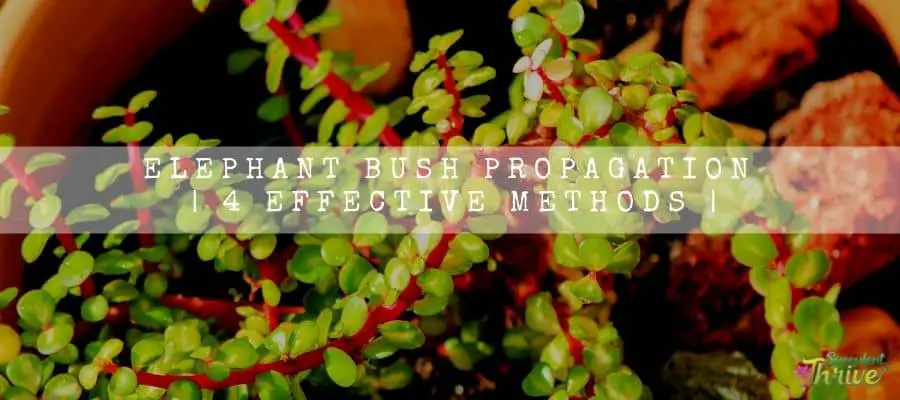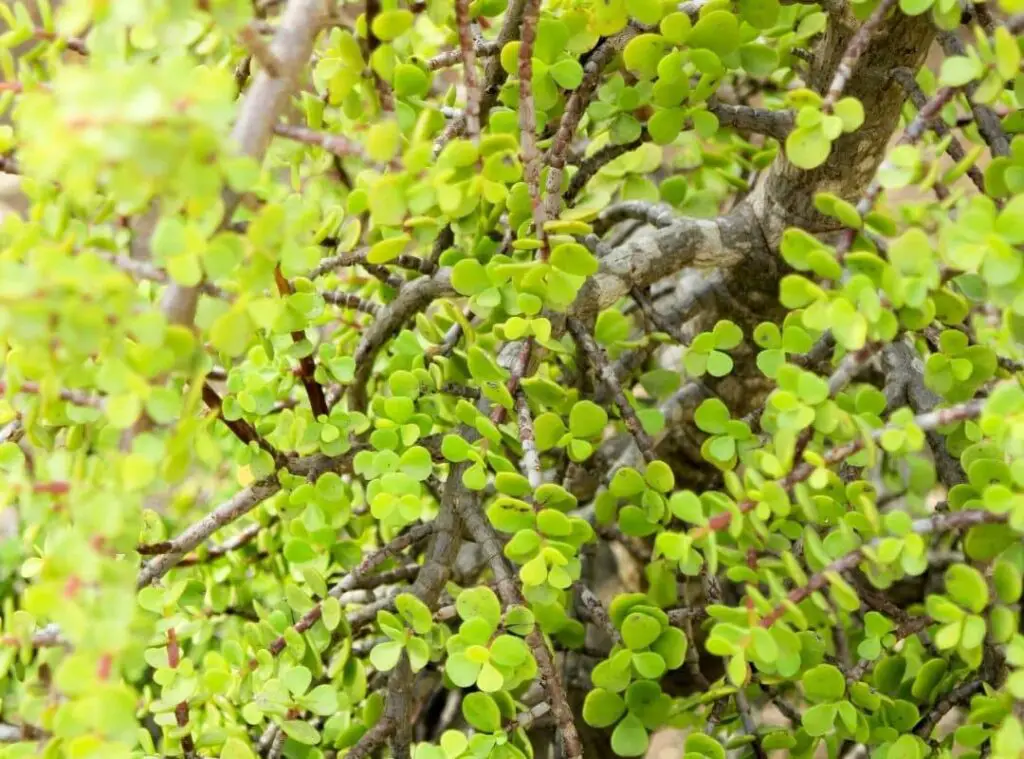When it comes to elephant bush propagation, it only requires a minimum input whereas there will be major output as it will reward you with flourishing plants in return.
The best mode of propagating the Elephant bush plants is using their stem cuttings. You could reap the best results of the propagation either in spring or in summer.
So, this article is about how to propagate them properly and how to look after them well too.

What is an elephant bush plant?
Elephant bush plants are native plants to South Africa where they are used to grow in hot and arid weather conditions.
Elephants are fond of eating these plants and hence they have inherited the common name called elephant bush.
To briefly explain the plant appearance, they usually have leaves in green and stems in red. You could spot them growing upward, downward.
However they grow quite attractive no matter how they grow. One more notable mention on the string of button plants is their flowering activity. They produce blooms in pink.
Can you propagate Elephant bush ?
You could use Elephant bush plant cuttings to propagate them and that is the most commonly used method. Besides that, you could use their leaf cuttings also to propagate them.
Elephant bush propagation by stem cutting
Using the cutting method is an easy way of propagating the string of button plants. It will allow you to have faster results as well.
You could expect them to root within four to six weeks’ time if you use the cutting method. Ideally you need to get the cuttings during spring or summer so that you could allow them to establish.
You may use a sterile knife or a pair of scissors to take the cuttings from the plants. You may use several cuttings to have best results and that will allow you to have a bushy plant when you plant them too.
Once you get the cuttings, allow them to wither and develop callous. The purpose of letting them develop callous is that, then they will not be subject to any fungal or bacterial infection during this process.

Elephant bush propagation by leaf cuttings
You could use elephant bush leaves to propagate them.
However, the leaf propagation method is somewhat time consuming as they take a plenty of time to become fully grown plants. That is because you need to start the leaf propagation method by scratch.
However, you may use the leaves which you mistakenly cut off from the plants during maintenance such as during pruning and repotting.
However, ensure that the leaves are healthy. You need to allow them to become calloused just like in the stem cutting method and then plant them in the soil.
Do they produce seeds?
Elephant bush plants produce seeds.
You could spot the seeds pods in the older plants which are healthy, and which produce a spathe and spadix.
You may use their seeds also to propagate them, but very rarely. Furthermore, there will be less successful results and it is time consuming too.
Can you root Elephant bush propagation in water?
You may conduct the elephant bush plant’s propagation in water instead of soil.
Here the growing medium would be water and if you are looking for a less messy propagation process, you could go ahead with the water propagation method.
You could spot them forming roots within a few week’s time. If you propagate the cuttings in water, you could go ahead and plant them in soil when the roots are a few inches in length.
If you are using the leaf cuttings to propagate them, you could first take a container and fill water with it. Then cover it with a plastic wrap.
Next you may poke the leaves in the wrap whilst ensuring that they are slightly above the water layer. The leaves base will be submerged whilst exposing the leaf bulk to water.
This is the only different step you need to take when propagating them in water compared to propagating them in soil.
Optionally you may dip the cut ends in a rooting hormone before you plant them. It is mandatory to do so.
However once you do it, it will assure you the best and faster results. If you are an impatient gardener , you could proceed with this step.
There are instances if you leave the cuttings to be in water for too long, they may not grow well in soil.
Hence, ensure that you are taking the plants off from the water at the right time whenever they are ready to be transplanted. When you plant them in soil, you treat the plants as regular plants.

How to treat after propagation
Sunlight requirement
Full sunlight to partial shade would go well with these plants. They would grow well if they get bright and indirect sunlight.
When you grow them indoors, a brightly lit room would be ideal for them for their survival. Alternatively you may place them in a covered porch as well.
Refrain in exposing them to intense direct sunlight levels in harsh summer conditions.
4-5 hours of bright indirect sunlight would be optimal for these plants. Ideally grow them in a place where they can gain full sunlight in the morning and semi shade in the afternoon.
Ensure that they get adequate sunlight levels as they need to conduct the photosynthesis process.
Water requirement
Elephant bush plants are undemanding when it comes to water as they can thrive with less watering. Once a week watering would go well with these plants.
However you need to adjust the watering frequency depending on the temperature and the humidity conditions of the area you live in.
Whenever you supply them water, ensure that there is no excess water is retained in the pot and the soil is not soggy.
You need to ideally soak the plants well with water and eventually should let them dry. Ensure that no excess moisture is conserved in the pot and all the excess moisture is draining from the potholes.
If you end up over watering the plants, that could bring so many harmful effects on the plants. Hence, be vigilant to not to provide excess water for them at any given time.
Soil requirement
Elephant bush plants optimal growth would be benefitted from a well-draining and a nutritious soil mix.
Ideally the perfect soil mix for them should conserve some water and drain the additional water. I encourage you to use a cactus soil mix or a succulent soil mix for this purpose.
Alternatively, you may proceed with an amended potting soil. To amend it you could add elements such as perlite coarse sand etc.
Ideally you need to add 2 parts of commercial potting soil, 1 part of perlite and 1 part of coarse sand. You could use gravel instead of coarse sand.
Temperature and Humidity requirements
A temperature range of 15 degrees Celsius – 30 degrees Celsius would go well with these plants when they are actively growing.
The minimum temperature they can withstand is 5 degrees Celsius – 10 degrees Celsius. However if there are further drops in the temperature levels, you need to bring them indoors so that frost conditions will not make any terrible impact on the plants growth and on the health.
Further you could protect the plants from covering them with frost clothes and keep them outdoors too.
In terms of the right humidity levels, a humidity range of 30 % – 50 % would be ideal for the elephant bush plants. If there are less humidity levels, as it would make the plants wilt.
Fertilizing requirement
Elephant bush plants are not demanding when it comes to fertilizers. However, feeding them lightly would be beneficial for the good health of the plants.
You may feed them less often as once every couple of months when they are in their actively growing phase.
If you end up over feeding the plants, it would be harmful for the plants and chances are that it could even bring fatal repercussions also on them.
The right fertilizer type should be a balanced liquid fertilizer. Further you should dilute it to half strength and use it too. Apply it onto the soil without spilling it on the leaves. Avoid feeding them in their dormancy.
Related questions
How do you root Elephant bush cuttings?
You may use stem cuttings of the plants which have a few plump leaves. You could follow the aforesaid steps to propagate them.
Simply, you need to obtain the cuttings and allow them to become callous. Place them in a soil mix which is moist, and you could expect them to form roots within 1-3 weeks’ time.
How do you separate Elephant bush pups?
You need to first water the ground and dig the roots whilst using a trowel. Next cut the branches into small parts and then place them in a pot which is filled with a right potting medium.
Does the Elephant bush need sunlight?
Full sunlight to partial shade would go well with these plants. Therefore, grow them in a location where they can gain 4-5 hours of full sunlight preferably in the morning hours.
Select a brightly sunny spot to grow them indoors. If the plants are lacking sufficient sunlight, you will see how they become etiolated.
How long does it take an Elephant bush to root?
It will take four to six weeks’ time to root
Finally
Before concluding, we have covered how to conduct the propagation of the elephant bush plants in this article and hope you found them interesting and useful.
We have covered how to use their leaf cuttings and stem cuttings to propagate them and on their aftercare tips as well.
Read Next : Aeonium Decorum Propagation | Every Small detail In One Guide | Aeonium Sunburst Propagation | This is The Only Guide You Need | Aeonium Arboreum Propagation (Now You Know How To Make More)
